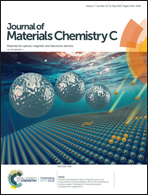The formation mechanism of TiO2 polymorphs under hydrothermal conditions based on the structural evolution of [Ti(OH)h(H2O)6−h]4−h monomers†
Abstract
In the hydrothermal synthesis of TiO2, [Ti(OH)h(H2O)6−h]4−h (h is the hydrolysis ratio) monomers are generated by the dissolution of the precursor containing titanium ions and then, the monomers form TiO2 crystals via a condensation reaction. In this study, the formation mechanism was investigated by the hydrolysis ratio rather than reaction parameters, such as pH value and temperature, and it was proposed that the hydrolysis ratio determines the crystal structure. According to the principle that the olation reaction occurs prior to the oxolation reaction, the detailed nucleation process of TiO2 was derived by a [Ti(OH)h(H2O)6−h]4−h monomer with different hydrolysis ratios, and the corresponding relationship between the hydrolysis ratio and the crystal structure was investigated. When the hydrolysis ratio is in the intervals of h ≤ 2, 2 < h < 3, 3 ≤ h < 5 and h ≥ 5, the predicted crystal structures of TiO2 are rutile, a mixed crystal (rutile, brookite and anatase), anatase and brookite, respectively. Under hydrothermal conditions, the change in temperature leads to the change in the ionization of water, which leads to the deviation in the hydrolysis ratio. In order to solve this problem, the calculation method of hydrolysis ratio (h) under different hydrothermal conditions was established by introducing the ionic product correction. Moreover, the hydrolysis ratio dynamically changed by the condensation reaction of a [Ti(OH)h(H2O)6−h]4−h monomer during hydrothermal crystallization, and it may shift to the adjacent crystal formation interval, resulting in the formation of the corresponding TiO2 at a new interval. The crystal structure of TiO2 synthesized at different hydrolysis ratios by the hydrothermal method with Ti(OH)4 as the precursor was consistent with the theoretical predictions.
![Graphical abstract: The formation mechanism of TiO2 polymorphs under hydrothermal conditions based on the structural evolution of [Ti(OH)h(H2O)6−h]4−h monomers](/en/Image/Get?imageInfo.ImageType=GA&imageInfo.ImageIdentifier.ManuscriptID=C9TC00662A&imageInfo.ImageIdentifier.Year=2019)


 Please wait while we load your content...
Please wait while we load your content...